
HMS Kingston was a K-class destroyer of the Royal Navy.

The Regia Marina was the navy of the Kingdom of Italy from 1861 to 1946. In 1946, with the birth of the Italian Republic, the Regia Marina changed its name to Marina Militare.

The Battle of the Mediterranean was the name given to the naval campaign fought in the Mediterranean Sea during World War II, from 10 June 1940 to 2 May 1945.
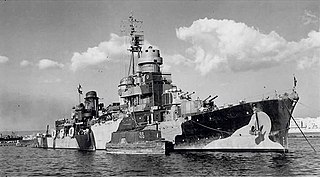
The Capitani Romani class was a class of light cruisers acting as flotilla leaders for the Regia Marina. They were built to outrun and outgun the large new French destroyers of the Le Fantasque and Mogador classes. Twelve hulls were ordered in late 1939, but only four were completed, just three of these before the Italian armistice in 1943. The ships were named after prominent ancient Romans.

The Freccia-class destroyer was a class of destroyers built for the Regia Marina in the 1930s. Four modified ships were built and delivered in 1933 for Greece.

The Turbine-class destroyer was a group of eight destroyers built for the Regia Marina in the 1920s. The ships played a minor role in the Spanish Civil War of 1936–1937, supporting the Nationalists. All the ships of the class were lost during World War II.
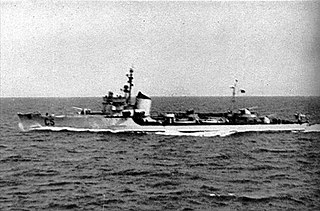
The Spica class were a class of torpedo boats of the Regia Marina during World War II. These ships were built as a result of a clause in the Washington Naval Treaty, which stated that ships with a tonnage of less than 600 could be built in unlimited numbers. Thirty-two ships were built between 1934 and 1937, thirty of which entered service with Italy and two which were sold to the Swedish Navy in 1940. The two units in Swedish service were classed as destroyers until 1953, then re-classified as corvettes. Although commonly referred to as torpedo boats due to their smaller displacement, the Spica class armaments were similar in design to destroyers, and were intended for anti-submarine duties, although they often had to fight aircraft and surface forces as well. Twenty-three vessels were lost during World War II.
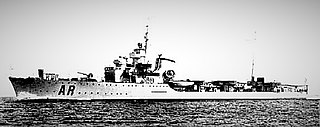
The Soldati class were a group of destroyers built for the Regia Marina during World War II. The ships were named after military professions. There were two batches; twelve ships were built in 1938–1939, and a second batch of seven ships were ordered in 1940, although only five were completed.

The Maestrale class were a group of destroyers built for the Regia Marina and served in World War II. They formed the basis for subsequent Italian destroyer designs; the Oriani and Soldati classes.
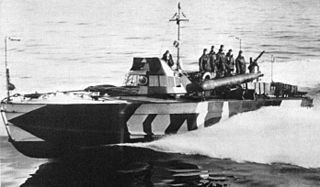
Motoscafo armato silurante, commonly abbreviated as MAS, was a class of fast torpedo-armed vessels used by the Regia Marina during World War I and World War II. Originally, "MAS" referred to motobarca armata SVAN (armed motorboat SVAN, Società Veneziana Automobili Navali.

The Adriatic campaign of World War II was a minor naval campaign fought during World War II between the Greek, Yugoslavian and Italian navies, the Kriegsmarine, and the Mediterranean squadrons of the United Kingdom, France, and the Yugoslav Partisan naval forces. Considered a somewhat insignificant part of the naval warfare in World War II, it nonetheless saw interesting developments, given the specificity of the Dalmatian coastline.

Lepanto was an Azio-class minelayer of the Italian Navy. She was reclassified as gunboat in 1934 and remained in Italian service in the far east from 1933 to 1943, when she was scuttled in China, during World War II. She was then recovered by the Imperial Japanese Navy and taken into service as Okitsu, spending the remainder of the war escorting convoys. She was surrendered to the Republic of China after the end of the war and served for a further ten years with its navy as the Hsien Ning.
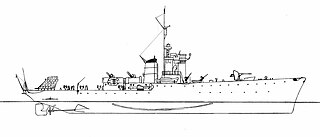
The Gabbiano-class corvettes were a group of 59 vessels built for the Regia Marina of Italy for service during the Second World War. They were built to a war-time design and intended for anti-submarine and escort duties.

Roma, named after two previous ships and the city of Rome, was the third Littorio-class battleship of Italy's Regia Marina. The construction of both Roma and her sister ship Impero was due to rising tensions around the world and the navy's fear that only two Littorios, even in company with older pre-First World War battleships, would not be enough to counter the British and French Mediterranean Fleets. As Roma was laid down almost four years after the first two ships of the class, some small improvements were made to the design, including additional freeboard added to the bow.

The Argo-class was a class of two coastal submarines built by Cantieri Riuniti dell'Adriatico in Monfalcone for Portugal but operated by the Royal Italian Navy after Portugal was unable to pay construction costs. The submarines were built in 1936, and both served in the Mediterranean Sea at the start of the Second World War. The boats were transferred to the BETASOM Atlantic submarine base at Bordeaux in 1940, but returned to the Mediterranean in 1941, where both were sunk within a few days of the September 1943 Italian armistice.

Delfino was one of four Squalo-class submarines built for the Regia Marina during the late 1920s. The boat served in World War II and was sunk in 1943 after a collision with another Italian ship.

The Battle off Zuwarah was a naval night encounter during the Second World War. The battle took place in Libyan waters between the Royal Navy and the Regia Marina. An Italian flotilla of small minesweepers and auxiliary vessels evacuating Tripoli was destroyed by two British destroyers.

The Squalo-class submarines were a group of four submarines built for the Royal Italian Navy during the 1930s. They were built at the Cantieri Riuniti dell'Adriatico (CRDA) shipyard at Monfalcone, and designed by Curio Bernardis.

Operation Scylla was the transit of the Regia Marina Capitani Romani-class light cruiser Scipione Africano on the night of 17/18 July 1943, during the Second World War. The cruiser sailed from La Spezia in the Tyrrhenian Sea to Taranto in the Ionian Sea during the Allied invasion of Sicily.

Scipione Africano was an Italian Capitani Romani-class light cruiser, which served in the Regia Marina during World War II. As she commissioned in the spring of 1943, the majority of her service took place on the side of the Allies - 146 wartime missions after the Armistice of Cassibile versus 15 before. She remained commissioned in the Italian navy after the war, until allocated to France as war reparations by the Paris Peace Treaties of 1947. Scipione Africano was decommissioned from the Marina Militare in August 1948 and subsequently commissioned into the Marine Nationale as Guichen, after briefly being known as S.7.

















